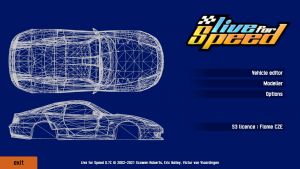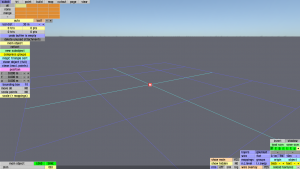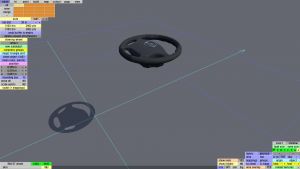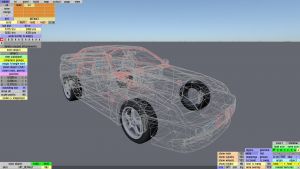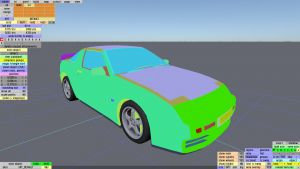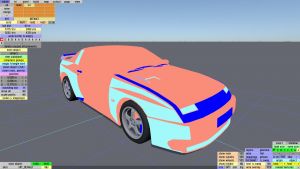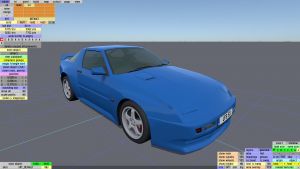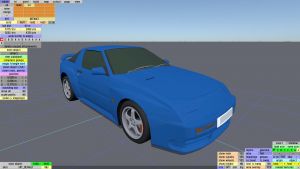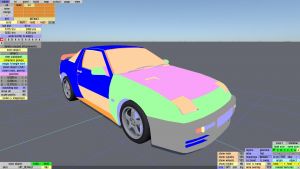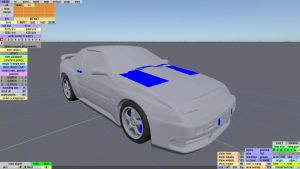Difference between revisions of "LFS Editor/Modeller"
(Saving & loading models in modeller - add screenshots, add warning about OBJ licenses) |
|||
| Line 4: | Line 4: | ||
For user guides and walkthroughs for various modeller features, see [[Modeller Guides]]. | For user guides and walkthroughs for various modeller features, see [[Modeller Guides]]. | ||
| − | |||
| − | |||
| − | |||
== Requirements == | == Requirements == | ||
| Line 13: | Line 10: | ||
== Starting the modeller == | == Starting the modeller == | ||
| + | |||
| + | [[image:LFS Editor welcome screen.jpg|thumb|Entry screen]] | ||
| + | [[image:LFS Modeller - start screen.png|thumb|Modeller start screen]] | ||
Once you have the editor installed and run the LFS Editor application, you will be presented with the entry screen. Click the {{button|Modeller}} button to enter the modeller. | Once you have the editor installed and run the LFS Editor application, you will be presented with the entry screen. Click the {{button|Modeller}} button to enter the modeller. | ||
| Line 27: | Line 27: | ||
* Press {{key press|Shift|F}} to temporarily hide the editor buttons. | * Press {{key press|Shift|F}} to temporarily hide the editor buttons. | ||
* To reduce clutter, use {{old button|hide selected|#ffffa1}} to temporarily hide points and triangles, then {{old button|unhide all|#a1ffa1}} to show the again. | * To reduce clutter, use {{old button|hide selected|#ffffa1}} to temporarily hide points and triangles, then {{old button|unhide all|#a1ffa1}} to show the again. | ||
| + | |||
| + | <br style="clear: both" /> | ||
== Loading a model == | == Loading a model == | ||
| − | You can load either an existing object made in the LFS editor, or an external model in OBJ format. | + | [[image:Modeller RB4.jpg|thumb|RB4 GT loaded in modeller through [[Vehicle Editor]]]] |
| + | [[image:RB4 modeller standalone.jpg|thumb|RB4 GT loaded in modeller using the 'LOAD' function. Notice the absence of wheels because the object was not loaded through the [[Vehicle Editor]].]] | ||
| + | [[image:Modeller subobject.jpg|thumb|The RB4 GT steering wheel loaded in modeller]] | ||
| + | |||
| + | You can load either an existing object made in the LFS editor, or an external model in OBJ format. The corresponding buttons are located in the bottom left corner of the screen: | ||
| + | |||
| + | [[image:Modeller load and save objects.jpg|The RB4 GT steering wheel loaded in modeller]] | ||
=== Loading an entire vehicle made in LFS editor === | === Loading an entire vehicle made in LFS editor === | ||
| Line 38: | Line 46: | ||
To go back from the modeller to the vehicle editor, press {{key press|Esc}} - the changes done in the modeller will be carried over automatically, there is no need to save it explicitly. | To go back from the modeller to the vehicle editor, press {{key press|Esc}} - the changes done in the modeller will be carried over automatically, there is no need to save it explicitly. | ||
| − | === Loading an object === | + | === Loading an object saved in LFS editor === |
| − | To load a standalone object saved from the modeller or the [[Vehicle Editor]], click the {{old button|LOAD|#00ff00}} button | + | To load a standalone object saved from the modeller or the [[Vehicle Editor]], enter the modeller in a standalone mode from the LFS editor entry screen and then click the {{old button|LOAD|#00ff00}} button at the bottom left of the screen. Such object can be either the main object (car body) or a subobject, like a steering wheel. |
| − | === Loading an OBJ file === | + | === Loading an external OBJ file === |
| − | If you have a 3D model in OBJ format that you want to import into the modeller, you can load it by clicking the {{old button|OBJ|#ffffa1}} button at the bottom left of the screen. The file must be located in the 'data\obj' directory and must have a '.obj' extension. | + | If you have a 3D model in [https://en.wikipedia.org/wiki/Wavefront_.obj_file OBJ format] that you want to import into the modeller, you can load it by clicking the {{old button|OBJ|#ffffa1}} button at the bottom left of the screen. The file must be located in the 'data\obj' directory and must have a '.obj' extension. |
The OBJ file must be exported properly to be useable in the LFS editor. You can read about [[LFS_Editor_Guides#Importing_from_other_3D_modelling_software|importing from other 3D modelling software]] on the [[LFS_Editor_Guides|guides]] page. | The OBJ file must be exported properly to be useable in the LFS editor. You can read about [[LFS_Editor_Guides#Importing_from_other_3D_modelling_software|importing from other 3D modelling software]] on the [[LFS_Editor_Guides|guides]] page. | ||
| + | |||
| + | ==== Warning about licenses ==== | ||
| + | |||
| + | If you are using a file made by someone else as part of your model, even if you modify it, you will need to declare this when you upload your mod. | ||
| + | |||
| + | You will need to specify the license that the original creator applied to the model and provide information such as the name of the creator and a link to a website where the license information is displayed. | ||
| + | |||
| + | If no license is stated, by you or the original creator, you cannot upload the mod! | ||
| + | |||
| + | Some licenses do not allow you to create work by changing the model you downloaded. | ||
| + | |||
| + | Please check that the supplied license allows you to distribute modified versions of the original model. | ||
== Saving a model == | == Saving a model == | ||
| Line 52: | Line 72: | ||
=== Saving a standalone object === | === Saving a standalone object === | ||
| − | To save a model as a standalone object, click the {{old button|SAVE|#00ff00}} button | + | To save a model as a standalone object, click the {{old button|SAVE|#00ff00}} button at the bottom left of the screen. The object will be saved into the 'data\3dob' folder, which can be loaded again through the modeller or [[Vehicle Editor]]. |
If you have entered the modeller through the [[Vehicle Editor]], there is no need to save the model explicitly. You can go back to the vehicle editor by pressing the {{key press|Esc}} key. | If you have entered the modeller through the [[Vehicle Editor]], there is no need to save the model explicitly. You can go back to the vehicle editor by pressing the {{key press|Esc}} key. | ||
| + | |||
| + | <br style="clear: both" /> | ||
== View modes == | == View modes == | ||
Revision as of 19:07, 7 August 2022
| This page or section is being initially created, or is in the process of an expansion or major restructuring. You are welcome to assist in its construction by editing it. |
The Modeller is a part of the LFS Editor. It is used to edit the 3D model, which includes editing the mesh and applying textures.
For user guides and walkthroughs for various modeller features, see Modeller Guides.
Requirements
To be able to use the modeller, you must have an S3 license. To get the S3 license, you can visit the LFS shop page.
Starting the modeller
Once you have the editor installed and run the LFS Editor application, you will be presented with the entry screen. Click the Modeller button to enter the modeller.
The modeller can also be entered from the Vehicle Editor by pressing E or clicking the E - Edit Model button on the right hand side of the vehicle editor.
General modeller tips
- The list of colours at the bottom left in 'tri' mode is a different view of the list of mappings in 'map' mode.
- When you select a triangle, its colour is selected in the bottom left list. If the list is long, click cols : X to bring the selected colour onto screen.
- In 'subob' mode you can select a subobject with Ctrl + click while pointing at one of its surfaces.
- In 'tri' mode, Ctrl + click adds or removes triangles from the selection. Alt + click starts a new selection (one triangle).
- In the special view modes (like groups or mappings) the group select feature (Ctrl + ⇧ Shift + click) does a flood select within the group.
- Press ⇧ Shift + F to temporarily hide the editor buttons.
- To reduce clutter, use hide selected to temporarily hide points and triangles, then unhide all to show the again.
Loading a model
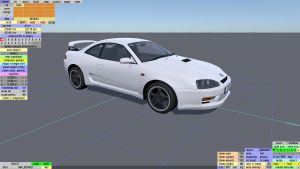
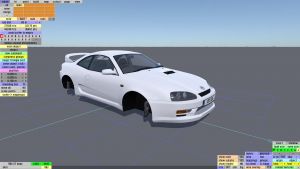
You can load either an existing object made in the LFS editor, or an external model in OBJ format. The corresponding buttons are located in the bottom left corner of the screen:
Loading an entire vehicle made in LFS editor
An existing vehicle model can be loaded into the modeller by loading a vehicle in the Vehicle Editor and switching to the modeller by pressing E or clicking the E - Edit Model button.
To go back from the modeller to the vehicle editor, press Esc - the changes done in the modeller will be carried over automatically, there is no need to save it explicitly.
Loading an object saved in LFS editor
To load a standalone object saved from the modeller or the Vehicle Editor, enter the modeller in a standalone mode from the LFS editor entry screen and then click the LOAD button at the bottom left of the screen. Such object can be either the main object (car body) or a subobject, like a steering wheel.
Loading an external OBJ file
If you have a 3D model in OBJ format that you want to import into the modeller, you can load it by clicking the OBJ button at the bottom left of the screen. The file must be located in the 'data\obj' directory and must have a '.obj' extension.
The OBJ file must be exported properly to be useable in the LFS editor. You can read about importing from other 3D modelling software on the guides page.
Warning about licenses
If you are using a file made by someone else as part of your model, even if you modify it, you will need to declare this when you upload your mod.
You will need to specify the license that the original creator applied to the model and provide information such as the name of the creator and a link to a website where the license information is displayed.
If no license is stated, by you or the original creator, you cannot upload the mod!
Some licenses do not allow you to create work by changing the model you downloaded.
Please check that the supplied license allows you to distribute modified versions of the original model.
Saving a model
Saving a standalone object
To save a model as a standalone object, click the SAVE button at the bottom left of the screen. The object will be saved into the 'data\3dob' folder, which can be loaded again through the modeller or Vehicle Editor.
If you have entered the modeller through the Vehicle Editor, there is no need to save the model explicitly. You can go back to the vehicle editor by pressing the Esc key.
View modes
In the bottom right part of the screen, you can choose different view modes of the model:
- layers
- Each colour represents triangles assigned to a particular layer. You can toggle layers on/off by clicking the layer buttons in the top left part of the screen.
- wire
- Shows the edges as a wireframe. The edges can have different colours:
- grey - two triangles share the edge. This is the normal condition for most edges in an object.
- red - an unshared edge - only one triangle uses this edge.
- cyan - three triangles share the edge.
- orange - four triangles share the edge.
- When you see an edge that is not grey, it may be intentional or it may draw your attention to a bug in the model. There are reasons to have unshared edges or multiple shared edges in some : : cases. But if it is not intentional, it may indicate a modelling error such as:
- A double built triangle - this would appear as a cyan triangle where you expect grey triangles.
- A triangle connected to the wrong vertex - could cause unshared edges.
- It's good to click wire mode occasionally and if you see edges that are not grey, make sure that you know the reason for them and that they are as intended.
- mappings
- Each colour represents a different mapping.
- flat
- Flat shading of the triangles without being smoothed.
- groups
- Smoothing groups. The boundaries between different smoothing groups usually have a sharp edge. All triangles within one smoothing group have artificial smoothing applied. In this mode, you can assign different smoothing groups to triangles by going to the "tri" mode, selecing one or more triangles and clicking the group number in the top right corner.
- gouraud
- The default rendering of the model with gouraud shading applied. This is how the car should appear in game.
- n.c.level
- Normal contribution levels. Each triangle meeting at a vertex, within the same smoothing group, contributes to the normal of that surface at that vertex. In fact, large triangles have a larger contribution. So for example you could make a simple "hardback book" shaped object and most of the apparent curvature would be on the spine of that book. But the spine would still be contributing to the normals, so the front and back faces of the "book" would still be a little curved. If, however, you set the normal contribution level" of the spine to zero, then the spine would not contribute to the normals at all. Then the front and back face of the book would look totally flat.
- l.r.swap
- Driver swap modes. The triangles can have different colours:
- grey - applied to mirrored triangles, which do not have any swapping
- blue (static) - do not change sides when driver side is swapped
- red (swap) - change sides when driver side is swapped
- In this mode, you can set driver swap modes to triangles by going to the tri mode, selecing one or more triangles and clicking one of the swap mode buttons in the top right corner.
| It is proposed that this article be deleted. |
